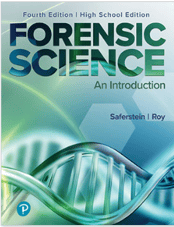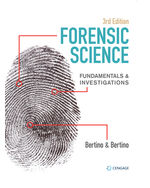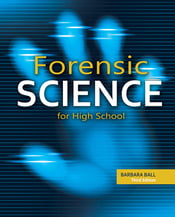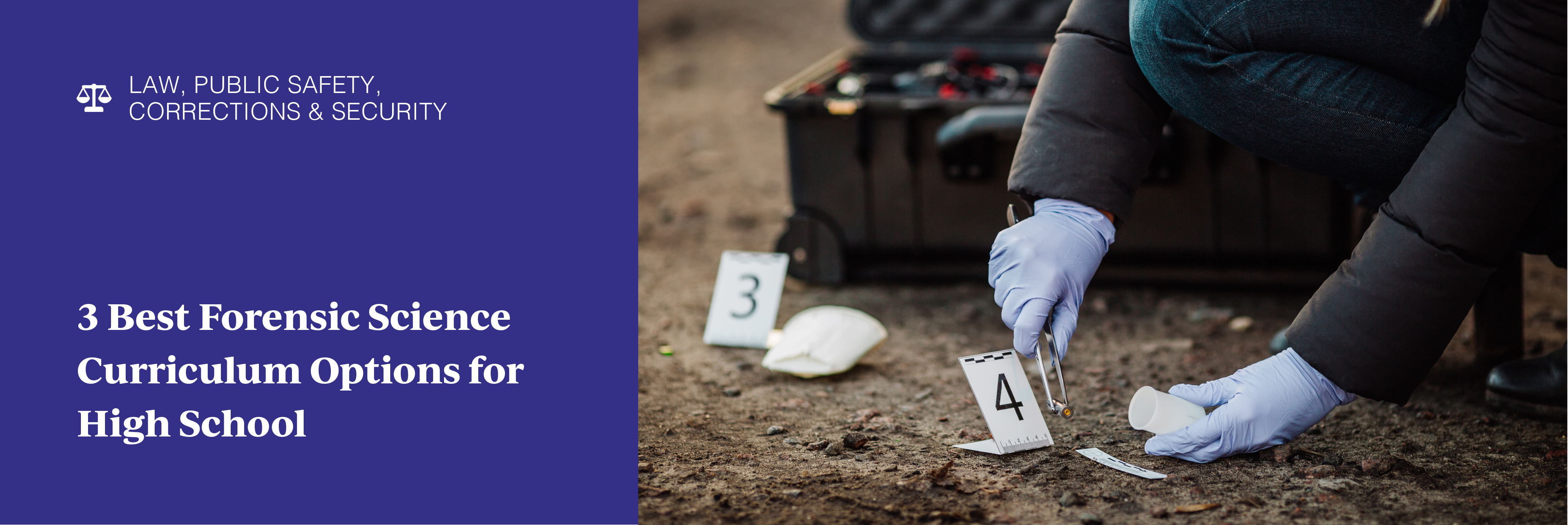Career and Technical Education (CTE) | High School | Law, Public Safety, Corrections and Security
3 Best Forensic Science Curriculum Options for High School
McKenna Garrison joined the iCEV marketing team in 2022 as the Content Marketing Specialist. Originally from a small town on the Gulf of Mexico, Garrison attended Texas Tech University from which she graduated with a B.A. in Public Relations & Strategic Community and an M.A. in Mass Communication & Media Studies. Garrison looks forward to bringing more of a storytelling element to iCEV social media pages. She also hopes to connect other CTE educators from around the country to the incredible curricula and resources iCEV has to offer.
As a Career and Technical Education (CTE) teacher, you’re often tasked with taking on new courses that may be unfamiliar to you. Teaching forensic science without a background in criminology is no different. It can feel intimidating to take on a new course and to determine the correct curriculum that will set your students up for success.
As the largest provider of online CTE curriculum, iCEV understands the need to find resources that not only allow you to feel comfortable with the content you’re teaching but also to feel confident that your students are prepared for what’s next once your class ends.
In this article, we’ll explore three forensic science curriculum options including:
- Forensic Science: An Introduction, 4th Edition from Pearson
- Forensic Science: Fundamentals & Investigations, 3rd Edition from Cengage
- Forensic Science for High School, 3rd Edition by Kendall Hunt
By the end of this article, you’ll be equipped with the information needed to choose the best curriculum for you and your students.
Forensic Science: An Introduction, 4th Edition by Pearson
 Forensic Science: An Introduction by Richard Saferstein and Tiffany Roy provides a first look into the world of forensic science for students and teachers. The textbook not only explores the basic elements of forensic science but also includes additional resources for teachers through MyLab Criminal Justice by Pearson.
Forensic Science: An Introduction by Richard Saferstein and Tiffany Roy provides a first look into the world of forensic science for students and teachers. The textbook not only explores the basic elements of forensic science but also includes additional resources for teachers through MyLab Criminal Justice by Pearson.
Forensic Science: An Introduction explores six chapters including:
- Introduction
- The Crime Scene
- Physical Evidence
- Death Investigation
- Properties of Matter and the Analysis of Glass
- Drugs
Additionally, MyLab, a digital resource, gives teachers access to multimedia materials like PowerPoints, flashcards, class assignments and chapter quizzes. As well as access to the most recent criminal justice current event videos, articles, and educational media to create a blended learning environment.
Who Is Forensic Science: An Introduction Intended For?
Forensic Science: An Introduction could be a good option for teachers new to teaching a forensic science high school course and looking to help their students understand the basic components.
This supplemental resource provides everything a teacher would need to get started including assignments, PowerPoints, and quizzes. However, the forensic science curriculum is lacking in hands-on classroom activities since it only provides digital resources for students.
If you’re looking for a comprehensive curriculum complete with digital and classroom activities, this might not be the best choice for your classroom.
How Much Does Forensic Science: An Introduction Cost?
Currently, there is no information in regard to cost readily available. However, there are printed textbooks and digital textbooks available but you must request information in order to purchase either option.
Forensic Science: Fundamentals & Investigations, 3rd Edition from Cengage
 Forensic Science: Fundamentals & Investigations by Anthony J. Bertino and Patricia Bertino offers a comprehensive, experiential approach that engages students in active learning. The text emphasizes the importance of incorporating core subjects like science, math, chemistry, biology, physics, and earth science with content aligned to the Next Generation Science Standards (NGSS).
Forensic Science: Fundamentals & Investigations by Anthony J. Bertino and Patricia Bertino offers a comprehensive, experiential approach that engages students in active learning. The text emphasizes the importance of incorporating core subjects like science, math, chemistry, biology, physics, and earth science with content aligned to the Next Generation Science Standards (NGSS).
NGSS are K–12 science content standards developed by states to improve science education and set the expectations for what students should know and be able to do in a science course.
Forensic Science: Fundamentals & Investigations consists of 18 chapters including:
- Forensic Science and Observation
- Crime Scene Investigation and Evidence Collection
- Hair Analysis
- Fiber Analysis
- Forensic Botany
- Fingerprint Analysis
- DNA Profiling
- Blood and Blood Spatter
- Forensic Toxicology
- Handwriting Analysis, Forgery, and Counterfeiting
- Forensic Entomology
- Death: Manner, Mechanism, Cause
- Soil Examination
- Forensic Anthropology
- Glass Evidence
- Casts and Impressions
- Tool Marks
- Firearms and Ballistics
Additionally, the textbook includes the digital resource, MindTap. MindTap allows students to hone skill sets and implement concepts learned in the book in a blended learning environment through capstone projects, interactive labs, and virtual labs.
Who Is Forensic Science: Fundamentals & Investigations Intended For?
Forensic Science: Fundamentals & Investigations could be a good fit for teachers looking to provide an engaging curriculum that explores the depths of the industry and allows students to implement what they’ve learned in a real-world setting.
However, while Forensic Science: Fundamentals & Investigations does provide teacher support through an annotated textbook and lab activities, it does not provide PowerPoints and other extensive resources first-year teachers may need to feel confident in teaching such a comprehensive course.
Additionally, while it does explore specialties within forensic science, your students could be overwhelmed by all the information provided if you’re only looking for a supplemental resource or a general overview of the industry.
How Much Does Forensic Science: Fundamentals & Investigations Cost?
Educators can purchase the Forensic Science: Fundamentals & Investigations textbook, the MindTap digital resource, and an Instructor Edition textbook through Cengage.
Currently, a hardcover textbook costs $111.75 and includes a free Instructor Edition textbook. You can also purchase a MindTap subscription for one year at $50 or a six-year subscription for $111.75.
Additionally, Cengage offers bundles of the textbook, instructor edition textbook, and MindTap subscriptions. A bundle with a one-year subscription will cost $119.50, while a bundle with a six-year subscription will cost $143.25.
Forensic Science for High School, 3rd Edition by Kendall Hunt
 Forensic Science for High School, written by Barbra Bell, provides a comprehensive exploration of the forensic science world. By focusing on the processes within forensic science and the critical thinking skills needed to solve crimes, this textbook allows students to grasp the foundational knowledge needed to start their journey to becoming forensic scientists.
Forensic Science for High School, written by Barbra Bell, provides a comprehensive exploration of the forensic science world. By focusing on the processes within forensic science and the critical thinking skills needed to solve crimes, this textbook allows students to grasp the foundational knowledge needed to start their journey to becoming forensic scientists.
Forensic Science for High School is comprised of 17 chapters, including:
- Introduction to Forensic Science and the Law
- Types of Evidence
- The Crime Scene
- Fingerprints
- Hair
- Fibers
- Drugs
- Toxicology: Poisons and Alcohol
- Trace Evidence
- Soil and Glass Analysis
- Blood
- DNA Analysis
- Forensic Entomology
- Human Remains
- Firearms, Toolmarks, and Impressions
- Document and Handwriting Analysis
- Cybercrime
By exploring the specific roles within forensic science, students can spark an interest and begin to understand the knowledge and skills necessary for a career path they may want to investigate further.
Who Is Forensic Science for High School Intended For?
The Forensic Science for High School textbook could be a good choice for you if you’re a seasoned forensic science teacher looking for an extensive forensic science high school curriculum and already have a resource for in-class activities, projects, and digital components.
However, this might not be the best option for you if you’re a first-year forensic science educator needing teacher resources, digital elements, or classroom activities.
How Much Does Forensic Science for High School Cost?
Currently, the Forensic Science for High School textbook is available in print or as an eBook. However, you can only purchase the eBook or a bundle of the textbook and the eBook. If you only want to purchase the eBook, it will cost $130, while the bundle will cost $140.
Which Curriculum is Best for My Forensic Science High School Course?
If you’re new to teaching forensic science, choosing the right curriculum for your students can be intimidating. Thankfully, there are plenty of options to ensure your students have the skills they need to succeed.
If you need a first look into forensic science with teaching resources and multimedia content for a blended learning environment, Forensic Science: An Introduction might be the right fit for you.
Foran engaging curriculum that allows students to practice skills in a real-world setting, Forensic Science: Fundamentals & Investigations could be a great choice.
Finally, if you’re a seasoned forensic science teacher looking for a comprehensive textbook for your in-class activities and projects, Forensic Science for High School might be what you’re looking for.
However, if these options don’t fit your needs, consider iCEV’s forensic science curriculum. iCEV’s comprehensive forensic science course explores terminology, investigative procedures, and the psychology of criminal behavior.
To learn more about the curriculum and if it’s right for your classroom, visit the forensic science course page:


